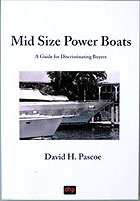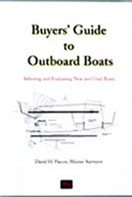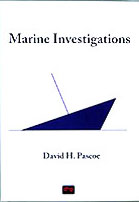Haul Out Basics
How
to avoid unexpected damage and invisible damage that can occur
during hauling and shoring operations.
by David Pascoe
Hauling a boat out of the water always entails some risk no matter how it's done. Dry storage facilities have long used fork lift trucks for this purpose, but its hard not to notice that these machines just keep getting bigger and bigger. The largest are rated at 15 and 20 tons or 30,000 to 40,000 lbs. These machines are adapted from those used at port facilities to handle shipping containers.
Fork Lifts
Several years ago my jaw dropped when I saw one of these behemoths hauling a 40’ sportfisherman which probably weighed around 35,000 lbs. In fact, a nearby marina is now routinely handling 35 – 40 footers with this monster. The question came to my mind as to whether boats are designed to be handled this way.
When a fork lift lifts a boat, all the weight of the boat settles onto the forks, obviously. What is less obvious is that how the weight is distributed on the forks depends entirely on the shape of the hull. When first used, fork lifts lifted outboards and stern drive boats. These boats all have their engines in the rear and their chines are relatively straight lines. That means that most likely the boat weight will be fairly well spread out on the forks. But what about boats with curved chines?
The potential for damage exists when too much of boat weight rests on one spot, as would be the case with a curved chine boat. FRP has many strong points, but point loads attack the weakness of the material. We see this all the time when untrained boat yard personnel set boats down on only two small blocks, sometimes resulting in the keel crushing.
Mid engine boats are much more at risk of being damaged when lifted with a fork lift. This is because this type of boat usually has a curved chine line. This makes for a load point rather like a basketball sitting on concrete – only a very small area of the hull bottom is bearing the entire weight of the vessel on the lift fork. The potential for damage is therefore very high. The risk is even higher for cored bottoms since these are even more vulnerable to point loading damage.
For example, Sea Ray made the mistake of coring its 54 footer all the way around the keel. The right way is to have only solid fiberglass where the two halves of the hull meet. In several cases, when set down on five 10” timbers as keel blocks, the keel crushed at all five points. The blocking was adequate but the construction of the keel with a core was not. Since most boats are bottom cored, this presents the same problem as the above example.
Typically a bottom core terminates right at the chine, the very point at which the fork lift will load the hull. This can result in crushing of the core as well as core disbonding. The damage can occur and not be noticed. Two things may then happen. First, the beginning of core disbonding is initiated and will become progressive due to stress during vessel operation. Secondly, core failure can occur through repeated hauling, eventually resulting in a fracture failure.
The question the reader will be asking is how do I know whether this is a problem for my boat. If you have an mid engine inboard engine boat chances are that it has not been designed to be lifted with a fork lift. Secondly, if your boat is more than five years old, it is very probable that it hasn’t been designed for this. If you have a stern drive boat, it is a reasonable assumption that it is designed with fork lifting in mind.
I’ve checked numerous boat owners manuals and the vast majority were entirely silent on the method of hauling, so the best thing is to call the builder before hauling on a fork lift. This should include all inboard boats above 30 feet. Moreover, as we see more and more boat yards replaced by condominiums, the probability is that reliance on forklift type marinas will increase.
Travel Lifts
This type of lift uses nylon slings and usually only causes hull damage when a hull is defective. On the other hand, damage to rub rails occurs routinely. Rail damage typically occurs either when the lift is small and the boat is large. In other words, the boat is wide enough that the straps will lift straight up and pinch the hull somewhat. The nylon slings stretch and insodoing pull the rail with them. If the rails are not strongly attached, they can either bend or be torn off. Normally the yard personnel will place bumpers under the rails to try to keep the slings off the rail, but this doesn’t always work. Sometimes the rail is just too weakly attached and it bends or pulls loose. The number of slings used doesn’t make much difference.
Hull pinching can occur when the beam of the boat approximates the spread of the straps. The most common lifts are 60 ton and 18 feet wide. Forty and fifty ton lifts are usually wide enough to avoid causing damage, but older 20 & 30 ton lifts are narrower and this is where I see most damage occurring. Boats around sixty feet have beams in this range. However, vessel beam is not the only factor. The depth of the haul slip plus the drop of time also affects the spread of the straps. The further down the vessel is, the more likely pinching will occur. Pinching by the straps places enormous loads on both the rails, deck and hull sides. It is not unusual to hear loud popping sounds when boats are lifted under such conditions. The popping, as you might guess, is fiberglass breaking within the hull. Damage is occurring though people are usually unaware of this as there are rarely any outward signs. However, visible damage does occasionally occur, typically in the form of cracks.
The best way to avoid these serious problems is; don’t haul larger vessels in smaller lifts such as the 30, 40 and 50 ton models, where the beam is approaching the maximum width of the lift. You know this when the vessel is a tight fit. Secondly, if there is a deep tidal fall – say four to six feet or more -- avoid hauling at low tide. If this is unavoidable, locate the internal bulkheads and get the straps placed on the bulkheads. Some builders mark the lifting points in this way, but many do not. Lifting on bulkheads will go a long way toward eliminating compression damage.
Now a word about large late model boats that have huge windows down near the deck, or even in the hull. The area in way of these windows is extremely weak and placing a lifting strap in way of the window can cause compression that results in the window seal being broken with resultant leakage. Some Carver boats are a prime example of this problem.
Whose fault is lift damage?
In most cases it is the boat builder’s for not making the boat strong enough to be lifted by normally available means. Dry storage marinas that use fork lifts have proliferated in the last decade or so. That means that builders should be well aware of the stresses placed on a hull when lifted this way, and should engineer their hulls accordingly. Thus, they cannot claim that abnormal handling is at fault. For larger, heavier vessels, this is not the case. It is very doubtful that 35-40 footers are designed with fork lifts in mind. If damage ensues as a result, assessing fault will be much more difficult.
If your rub rails tear loose on a travel lift, it's really not the yards fault; the boat should have been able to take it since most can. I can tell you from long experience that such cases brought against builders for damage rarely succeed because larger vessels are normally hauled this way. The rails should be designed to withstand these stresses. One exception might be that the builder fails to place fender blocks between the strap and rail, below the rail. Fender blocks will lessen the load on the rail, but not eliminate it. I’ve seen many rails damaged even with the use of fenders.
Having viewed several
thousand boat haulings first hand, it’s an understatement
to say that most hauling crews are sloppy and inconsiderate. It’s not
unusual to see one man trying to handle the whole show, nor is it unusual for
damage to occur simply through carelessness. It is prudent to whip out your
digital camera and take a few picks of the hull before delivering the boat
to the yard, particularly if you won’t be present when hauled. That’s
because when your hull scrapes against that low, unprotected concrete piling,
plowing a large gouge in the side, unless you can prove that it didn’t
occur previously, you don’t have a supportable claim. Oh, yes, and be
sure to turn on the camera’s photo dating facility.
Keel Blocking
A boat owner should not leave it to a boat yard to know how to block his boat. The yard cannot know whether the hundreds of hulls he deals with are strong or weak, or require special care. It is the boat owner’s responsibility to know this – this is a ship owner tradition hundreds of years old. As a rule of thumb, there should be one block for every 10 feet of vessel length on deck. Whenever in doubt, add one more. Never, ever suspend any hull between only two blocks – one at each end. The minimum is three. The width of the block is important, for this affects load bearing area of the keel and that is what this is all about. Block width should be no less than 8” for boats 40 feet and over. Under that, six inches minimum. No 4 x 4’s should be used.
What about jack stands? Occasionally I see boats in the 25-30’ range sitting on jack stands alone. Not good because boats are NOT designed to bear weight in that manner. The purpose of jack stands is hold the boat upright, not to hold the weight of the boat.
It is wise to draw yourself up a blocking plan – in old nauticalese known as a graving plan. It doesn’t have to be fancy, a rough drawing will do, e.g. keel blocks go here, here and here. Add any special instructions, such as sizing of keel blocks. Make a dozen copies and put them onboard. When needed, give to the yard manager telling him this is the way it should be done.
Winter Lay Up
Over the winter a boat will be resting on its keel for a very long time. For this reason it is extra important that adequate shoring be used. One very important feature that is often overlooked is that the keel blocks need to be level. Usually the yard men just throw them down and plunk the boat down on them. Think of what happens when two blocks are high and one is low. Effectively a three block shoring now has only two supporting blocks! Its not hard to imagine the effect of a heavy boat sitting like this for six months. A good yard will run a string level across the blocks to ensure that they are level.
So what’s the big deal about shoring except for possible keel crushing? It’s a misshapen hull. This is much less a problem for a short haul but for winter layup its definitely a big deal. The way they build boats today, it is a mistake to think that a fiberglass hull won’t distort; they can and they do.
Good yards have well prepared
storage areas that have been compacted by years of travel lift operation
over a heavy gravel surface. Before contracting for winter layup, make an
inspection of the storage area. What you don’t
want to see is soft ground where the travel lift wheels have sunk into the
surface, causing ruts. Note whether the area appears swampy or prone to standing
water. Frozen wet ground is bad news since it will turn to pudding come spring.
Posted October 29, 2006
 Visit davidpascoe.com for his power boat books
Visit davidpascoe.com for his power boat books 















David Pascoe is a second generation marine surveyor in his family who began his surveying career at age 16 as an apprentice in 1965 as the era of wooden boats was drawing to a close.
Certified by the National Association of Marine Surveyors in 1972, he has conducted over 5,000 pre purchase surveys in addition to having conducted hundreds of boating accident investigations, including fires, sinkings, hull failures and machinery failure analysis.
Over forty years of knowledge and experience are brought to bear in following books. David Pascoe is the author of:
In addition to readers in the United States, boaters and boat industry professionals worldwide from nearly 80 countries have purchased David Pascoe's books, since introduction of his first book in 2001.
In 2012, David Pascoe has retired from marine surveying business at age 65.
On November 23rd, 2018, David Pascoe has passed away at age 71.
Biography - Long version